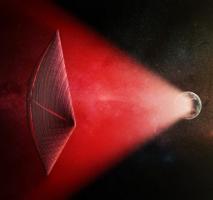
An artist’s illustration of a light-sail powered by a radio beam. Image: M. Weiss/Center for Astrophysics
Theorists at the Harvard-Smithsonian Center for Astrophysics have a intriguing idea as to what might be the nature of FRBs (fast radio bursts), an unexplained phenomenon first observed about ten years ago. FRBs are very short but incredibly powerful bursts of radio activity that appear on occasion from outside our galaxy.
In a recent paper, Fast Radio Bursts from Extragalactic Light Sails, Abraham Loeb and his co-author Manasvi Lingam suggest that the FRBs might be the light propulsion for alien sailing ships.
The Washington Post reports: FRBs could represent artificial beams, Loeb and Lingam wrote, created by a far-off civilization either as giant beacons or “for driving light sails.” Given the luminosity of the FRBs detected on Earth, an intelligent civilization would need to harness energy from a sun and cool the machinery with planet-sized amounts of water. Although alien traffic controllers would need to keep this beam aimed at the sail, distant observers would see only a flash as the beam pivoted across the universe.
When sailing by light, the sun’s radiation provides propulsion. If caught by a large enough sail and given adequate time, solar photons bouncing off a reflective surface could push a spacecraft with ever-increasing speeds.
The two Harvard theorists recognized that their FRB origin story dealt with possibility, not probability. “Deciding what’s likely ahead of time limits the possibilities,” Loeb said. “It’s worth putting ideas out there and letting the data be the judge.”
The idea of sails powered by light has long been a subject of science fiction. It is however an idea not limited merely to novels. A test version of a light powered sailing spaceship is being launched this year. It will not be power by high intensity radio waves but by the light of the sun.
As we posted in 2015, the Planetary Society has raised funds to put solar sail spacecraft in orbit on demonstration flights. In 2015, they launched LightSail 1 in a low orbit test. This year they plan on launching LightSail 2, a kite-shaped spacecraft will have a total sail area of 32 square meters (340 sq ft), and will be fitted with guidance and diagnostic electronics.
The Planetary website describes how the LightSail2 will be deployed:
Once in space, LightSail’s solar arrays swing open, revealing the inside of the spacecraft. Four tape measure-like metal booms slowly unwind from storage, unfolding four triangular, Mylar sails. Each sail is just 4.5 microns thick—one-fourth the thickness of an average trash bag.
Three electromagnetic torque rods and a momentum wheel orient LightSail in space. Ground-based lasers will measure the effect of sunlight on the sails. As LightSail breezes around the Earth, its shiny sails will be visible from the ground. We’ll organize viewing campaigns to show people where to look.
